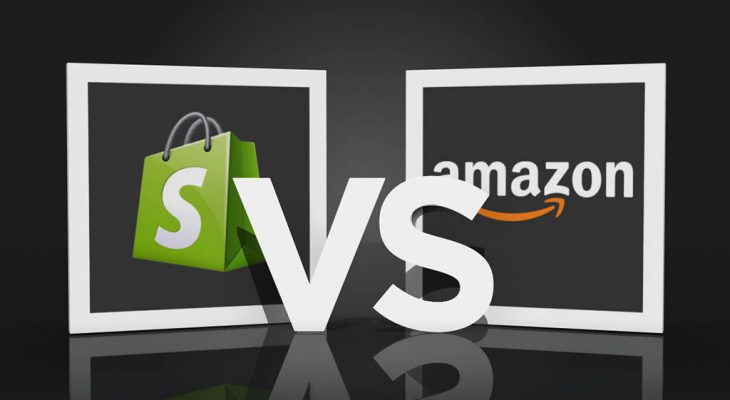As an online entrepreneur who sells products on with Shopify and Amazon, I’ve got a lot to say about this topic. Get ready to take copious amounts of notes, because I’m about to spew all the pros and cons about selling on Shopify versus Amazon. And more!
For those of you not interested in reading an entire article and you just want to know which one is better, the honest truth is this:
I much prefer selling on Shopify than I do on Amazon. Of course everyone’s situation is different, and the things that I don’t like about Amazon may be the things that you like. Funny how that works, eh?
Anyway, normally I would tell you to try both to see which one you prefer. However, that’s a very time consuming (and somewhat costly) endeavor, so I’m just going to break it down to you as openly and honestly as I can so you can choose the option that’s best for you.
Selling on Shopify vs Amazon: how do they compare?
When it comes right down to it, it’s relatively easy to find success on both Shopify and Amazon. After all, I am just a nobody who is consistently making over $1000 a month selling digital products on Shopify. I also have a book published on the Amazon Kindle store which does fairly well. If I can do it, anybody can.
However, as I’ve already mentioned, there’s a lot about Amazon that I don’t like and I much prefer having my own online store that I built using Shopify. Before I can explain my reasoning for that, let’s take a look at all of the features that both platforms offer in to see how they compare with one another:
| Shopify | Amazon | |
|---|---|---|
| Sell digital products (PDFs and e-books) |  |  |
| Sell physical products |  |  |
| Ability to serve as a completely hands-off drop-shipping solution |  |  |
| Ability to see who your buyers are (name, email address, etc) |  |  |
| Offer discounts and promo codes |  |  |
| Ability to brand your own store (with things like your logo and other information about you) |  |  |
| Cost | $29/mo - but you get to pocket the proceeds of every sale (minus several % in fees) | A percentage of every sale (it varies, but averages around 50%) |
As you can see, both platforms are fully capable e-commerce systems. You’ll get loads of great selling tools with each, and it wouldn’t be all that difficult to build an empire on either.
| Please note: some of the links in this article may be affiliate links. This means that I will get paid a commission if you buy something or take an action after clicking one of them. |
Pros and cons of selling products on Amazon
I think the best way to explain this whole Shopify vs Amazon thing is to break it down into a comprehensive pros and cons list based on my own personal experience. As you’ll see, there are some definite benefits to selling on Amazon. However, there are some very serious drawbacks as well.
Pros
- The main benefit (by far) is not having to deal with building a website. You just create an account at Amazon and you start listing your products. That’s it. It’s that easy.
- Amazon has a massive audience. As a matter fact, at the time of this writing, Amazon accounts for over 75% of all online sales in the United States. In other words, it’s where people go to buy stuff (all kinds of stuff).
- If you’re selling physical products, Amazon can handle all of the fulfillment (storage, packaging, and shipping) for you. It’s expensive, but they can do it.
Cons
- Competition is extraordinarily high on Amazon. Yes, even though it’s the number one online marketplace in the world, it doesn’t automatically mean that you’re going to have people buying your products the moment you list them. It takes a ton of promotion to get your products noticed. If you don’t do any promotion, you’re very unlikely to get sales.
- You’re at the mercy of the algorithm. Just like all the major social media channels, Amazon is driven by algorithms which control how frequently your products are showed to potential customers. In other words, even though they might be showing your product near the top of the search results today, a simple algorithm change tomorrow could send you all the way to the back (where nobody is even looking).
- Amazon is notoriously strict about rules and regulations, and they have a long history of banning peoples accounts for the smallest of reasons. You have to be 1000% certain that you are following all the rules perfectly, otherwise you’re at risk of losing your account and never getting it back. Not only that, these rules change often and you constantly have to stay on top of them. Or else.
- Remember, Amazon takes a large cut of everything you sell. For example, in the case of the e-book that I have listed on the Kindle store, I only get 50% of the $4.99 sale price. That’s a massive hit to my bottom line and one of the main reasons why I don’t like to sell on Amazon.
- Amazon is ruthless, and will do anything to crush you. Did you know that they create (and promote) their own products based on the data they harvest from the best selling products in many categories? In other words, they identify what products sell the best, and then create their own Amazon-branded products to push out the competition. And of course, those products will be at the top of the search results every time. It’s shady as heck.
Pros and cons of selling products on Shopify
This is the part of this Shopify vs Amazon comparison where I hope to start opening your eyes. Yes, Amazon may seem tempting since it’s the largest and most trusted retailer on the Internet, but as you just read, there are some very serious negatives. Shopify is much better in my opinion, and here’s why:
Pros
- You own your Shopify store. It’s 100% yours, which means that you are the boss and you make the rules. There are no algorithms to fight, and you can list products for sale at any price you desire.
- Speaking of price, the main benefit of selling on Shopify is that you get nearly 100% of the proceeds of every sale. Note that Shopify will take approximately 2% for credit card processing fees, but still. 98% is far better than the 50% that Amazon offers. Right?
- With Shopify, you’re not competing with everyone else. The only things displayed on each page are your products and the information about them. Nothing else. Compared to Amazon (who can show up to 30 competing products on your sales page), this is a major point when it comes to converting a potential customer to a paying customer.
- Another major benefit of selling on Shopify is that you know who your customers are. On Amazon, you’ll get no information about your buyers other than the general region of the world in which they live. With your own Shopify store, you’ll get their name and email address which is extremely important for building relationships with your customers and building email marketing campaigns. FYI, there are tons of great marketing apps available for Shopify which can help you create (and execute) campaigns that convert.
- It’s far easier to build a brand with Shopify. This is because you’ll get to brand your store with things like your logo and other bits of information like “About” and “FAQ” pages. Your customers will get to know you far quicker than they ever would on Amazon.
- Need help figuring out how to make money on Shopify? The online support community is huge – and very active.
Cons
- Because your Shopify store is a website that you organize and manage yourself, it’s going to take a little bit of time to set up exactly the way you want it. You’ll have to think about things such as categories, menu structures, and high-level things like that.
- There is a cost associated with Shopify, which is $29 a month at the time of this writing. Keep in mind that this is still far below the amount of money that Amazon will take from you every month for having our products listed on their website. If you’re a high-volume seller on Shopify, $29 a month it’s basically unnoticeable. FYI, Shopify does offer a free trial if you want to test before you commit.
A brief summary of my (failed) selling experience on Amazon – it’s not as easy as they tell you!
In order to really drive home the point about Shopify being a better solution for most people, I want to share with you the struggles that I’ve had selling an e-book on Amazon. Despite what all the gurus might tell you, it’s hard to make sales. Like, really hard.
I wrote the book back in 2017 as a way to monetize one of my other websites. This particular website was getting a decent amount of traffic and it was slowly (but surely) building an audience. I knew that I could sell copies of my books fairly easily to my existing audience if I could just get it written.

Long story short, I wrote the book over the fall of 2017, and launched it on January 1, 2018. My selling platform of choice was Amazon, and the entire process of getting it online and ready for purchase was fairly painless.
I promoted it to my audience via a blog post and an email and, not surprisingly, I made a few sales. However, sales stopped when I stopped promoting it. I thought for sure that Amazon was going to show it to thousands of potential buyers on a daily basis forever, but that never happened.
Amazon did absolutely nothing for me in terms of showing it to potential buyers, and it has remains buried in the search results since day one. To this day, I have never once had an organic sale from an Amazon customer.
Do I hate selling products on Amazon? No. Could I have generated more sales if I worked really hard to promote it better? Probably. But why would I want I have to work so hard to drive traffic to someone else’s website?
Build your own business (not someone else’s) with Shopify
Once I made the realization that it was going to be extremely difficult to get organic sales of my products on Amazon, it made me appreciate the process of building and creating a Shopify store even more. It was a no brainer, especially considering all the great marketing tools that are available for driving traffic to a Shopify store.
Basically, whether you use Shopify or Amazon, it’s going to take lots of work to get sales. And I don’t know about you, but if I’m going to spend a lot of time and effort on something, it better be on something that is going to benefit me for the long run – and not somebody else.
Focusing my efforts on building an e-commerce store that I own protects me from annoying things like algorithm and site structure changes. I never have to worry about waking up to a scary email informing me that my account has been banned for seemingly no reason.

I own my Shopify store. I feel great knowing that all the effort and time that I put into it won’t be obliterated in an instant due to something that I have no control over.
Why would you choose Amazon over Shopify?
Even though I feel like I’ve done a pretty good job of pooping on Amazon in this article, I don’t deny that there are some real benefits for going that route. I’ve already mentioned some of those in the pros and cons list above, but here are two other reasons why Amazon may be a better fit for you and the products that you sell:
- If all you want to do is make a little side income, selling products on Amazon works well. It’s an incredibly robust platform with many options for sellers of all experience levels.
- If you’re an experienced online retailer and you know how to create successful ad campaigns using Google AdWords or Facebook ads, you’re likely to do fairly well selling on Amazon. Personally, I’ve never been able to successfully crack the paid advertising nut, and what usually happens is that I end up throwing gobs of money away like it’s toilet paper.
Why would you choose Shopify over Amazon?
There are lots of good reasons. The fact that you’ll be in 100% control of your store is the biggest one, as is the ability to build relationships with your customers. Additionally:
- Shopify is a platform that can move with you. Since you’ll automatically be building a brand and an audience with your Shopify store, it’ll be easy to move it to another platform or whenever the time comes. Will Shopify last forever? Who knows. But rest assured that you’re building a real tangible asset that’s yours to keep for the rest of your life when you choose to sell products on Shopify instead of Amazon.
- Because you’ll be able to build relationships with your customers, that portion of your business alone may end up becoming more valuable than the store itself. After all, the best customers are repeat customers, and if you can get to know them and find out how to solve their biggest problems, you’ll have a profitable business for life. Good luck building those sorts of relationships on Amazon.
Finally, I’d also like to mention that GumRoad is an alternative to selling on Amazon as well. As a matter fact, I even wrote a full article comparing Gumroad to Shopify a short while back, and I highly recommend reading that to find out about selling your own products online without making Jeff Bezos even richer.




